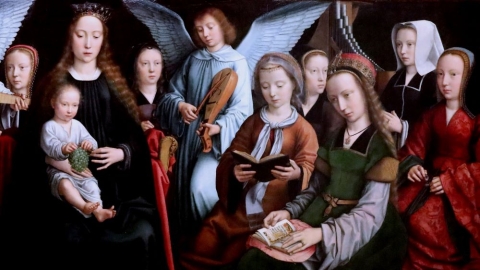Our Lady Máriapócs, the Weeping Icon

Church of Máriapócs with the Basilian Monastery
The Church of Máriapócs, Hungary, is the most famous and visited Marian shrine in the country. It is attached to a monastery of the Basilian Fathers of Saint-Josaphat, of the Byzantine rite. Every year, it welcomes 600,000 to 800,000 pilgrims of the Latin or Byzantine rite.
Story
The village, whose ancient name was Pócs, only became famous at the end of the 17th century. At the time, Hungary was still occupied by Ottoman troops: the population was dying of hunger and disease; Calvinism, introduced from Switzerland, was spreading, especially in the east of the country.
In 1696, László Csigár, had a painting made of the Virgin in thanksgiving for his miraculous escape from a Turkish prison, intended for the small church of the local Greek Catholic community, an icon was created by István Papp, brother of the parish priest.
On November 4, 1696, during the Mass, the icon of the Virgin Mary began to weep. This weeping would last fifteen days and continued intermittently until December 8. It was accompanied by many miracles: conversions of Muslims, Protestants, and healings.
The miracles attracted a growing number of pilgrims and the attention of the authorities. An Austrian flag officer examined the image. The bishop of Eger, Msgr. György Fenessy, had an inquiry made. After hearing from 53 witnesses – including Protestants – the miraculous reality of the facts was recognized.
The translation of the icon
Given the kingdom’s state of desolation, this event was recognized as providential by Leopold I, the Emperor of Austria and King of Hungary. He then requested the transfer of the miraculous icon to Vienna. However, a copy was left behind.
The translation was triumphant and the icon was welcomed by the Viennese in jubilation. The image was deposited in the cathedral – where it still is. The faithful prayed tirelessly to the Virgin to protect them from the Ottomans, partially repelled by the victory of Kahlenberg (1683). Soon, the danger was definitely averted by the victory of Zenta – currently in Serbia – obtained by Eugene of Savoy, one of the worst defeats ever inflicted on the Ottoman Empire.
In the region of Máriapócs, conversions multiplied, and the city became a center of fervent Catholicism for the whole region. Even though the inhabitants were sorry to have seen their precious image moved.
New tears
However, their devotion was rewarded. On August 1, 1715, during Mass, the copy left in place of the original icon began to weep. Hundreds of people were able to see this new wonder for three days. Msgr. Gábor Antal Erdődy, Bishop of Eger, had a new investigation carried out which concluded that the event was miraculous in nature, and it too was accompanied by miracles.
A third lachrymation occurred on December 3, 1905, a phenomenon that lasted until the end of the year. It was only the subject of a local investigation.
The churches
After the second lacrimation, the smallness of the first church necessitated the construction of a new one. The new church was built between 1731 and 1756 in Baroque style. The copy of the icon was then removed from the iconostasis, and put in its current place.
On December 1, 2005, Máriapócs was declared a national shrine, and Hungary was placed under the protection of Our Lady of Tears.
(Sources : Notre-Dame (Facebook)/biblisem.net/Wikipédia FSSPX.Actualités)
Illustration: Author unknown, CC BY-SA 2.5, via Wikimedia Commons





